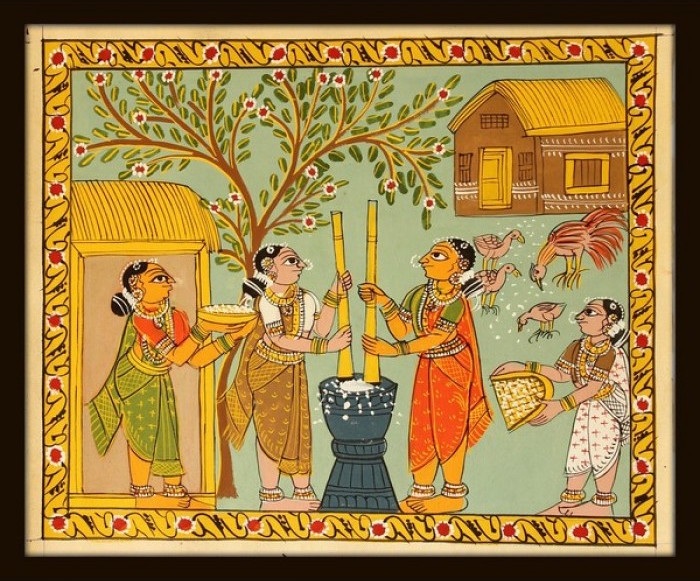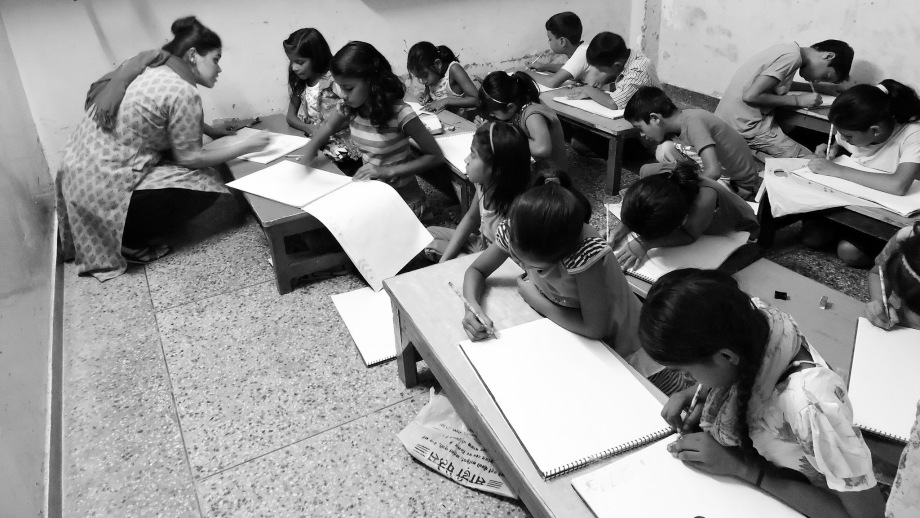
Storytelling traditions have been an integral part of different generations in India, with each region having it’s own unique style of narration. One such tradition is practiced in the region of Telangana, where Cheriyal artists depict stories on their canvases. Used as visual aids to keep different stories alive, the paintings are categorised with earthy colours made from natural stones, fine detailing done with brushes and a texture which comes from the khadi cloth used as a canvas.
If you are thinking that this is yet another tradition depicting gods and goddesses, then the art has much more to offer. The stories depict farmers, fishermen, weavers, boys and girls, women working in rice fields as their main characters with animals, birds, trees, musical instruments and things we come across in our daily lives. The interesting part about these scrolls is that they are done in vertical format with story illustrations in horizontal format, just like a comic strip.
The preparation of the canvas is a longer process. The khadi cotton cloth is treated three times with a mixture of rice starch, shuddh matti (white mud), a paste of boiled tamarind seeds and gum water.
The colours used in the art are organic and made from natural substances. Colours such as red, blue and green comes from natural stones; black from lamp soot mixed with tree gum; white from crushed, ground sea shells; lemon yellow from turmeric; a particular yellowish stone, red from tamarind seeds and brown from geru.
 Once the cloth and colours are ready, the artists sketch the outline directly on to the canvas using a brush. After the sketch is ready, the artists fill the background with red. The next step is to painting human figures and motifs are painted with primary colours. Finally the outlining of figures and borders is done with black colour to add the final touches to a painting.
Once the cloth and colours are ready, the artists sketch the outline directly on to the canvas using a brush. After the sketch is ready, the artists fill the background with red. The next step is to painting human figures and motifs are painted with primary colours. Finally the outlining of figures and borders is done with black colour to add the final touches to a painting.
Now, that you are aware of how a Cheriyal painting is made, are you excited to try your hand in making one?

 asses at Vidya and Child centre in Noida. She eagerly awaits for her class every week. Kajal is one of the hundred kids, studying at eight different centres in Delhi under this programme.
asses at Vidya and Child centre in Noida. She eagerly awaits for her class every week. Kajal is one of the hundred kids, studying at eight different centres in Delhi under this programme. Our journey till now has been very exciting given the sheer enthusiasm of everyone involved and the different experiences they bring. All our Educators are pursuing different things in life – but Patua Art and stories bring them together. It is perhaps too early to hope that our traditional arts will someday become great learning aids, but we can already see the impact it has on those learning, and the ones teaching. More than anything, to nurture young practitioners of an age-old art form has been a challenge worth pursuing.
Our journey till now has been very exciting given the sheer enthusiasm of everyone involved and the different experiences they bring. All our Educators are pursuing different things in life – but Patua Art and stories bring them together. It is perhaps too early to hope that our traditional arts will someday become great learning aids, but we can already see the impact it has on those learning, and the ones teaching. More than anything, to nurture young practitioners of an age-old art form has been a challenge worth pursuing.

 Neha knits mesmerizing stories like an old grandmother, while Shakeel has a keen sense of observation and the knack for moulding characters into a narrative. Suvendu is a hardworking, rather silent kid who’s untiring efforts at learning the Patua art form are like a breath of fresh air amidst the animated excitement Amit and Supriya’s magnanimous range of ideas bring forth.
Neha knits mesmerizing stories like an old grandmother, while Shakeel has a keen sense of observation and the knack for moulding characters into a narrative. Suvendu is a hardworking, rather silent kid who’s untiring efforts at learning the Patua art form are like a breath of fresh air amidst the animated excitement Amit and Supriya’s magnanimous range of ideas bring forth.